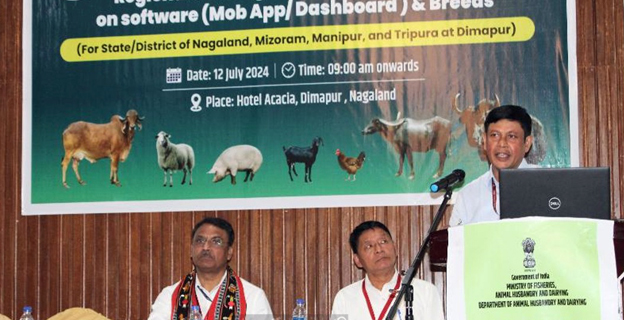Nagaland’s livestock sector has experienced a significant decline in its share of the Gross State Domestic Product (GSDP), dropping from 7.31% in 2013 to 2.19% in 2024. This data was highlighted by the Director of Economics & Statistics, Neidilhou Keditsu, during his address at a regional training on the 21st Livestock Census on 12 July 2024, which took place at Hotel Acacia, Dimapur. He highlighted the critical role of the livestock census in providing essential data for understanding livestock numbers, assessing government policies, and making future projections.

Keditsu expressed concerns over the negative growth rate in the livestock sector, which has impacted per capita income and the state’s economic security. He stressed the importance of meticulous data collection in the 21st Livestock Census to ensure reliable and accurate information, which is vital for effective policy execution and economic stability.
The training was conducted by the Ministry of Fisheries, Animal Husbandry & Dairying. The training was focused on software application and breed documentation for State. The training was hosted by the Department of Animal Husbandry & Veterinary Services, Nagaland.
Jagat Hazarika, ISS, Advisor (Statistics) from the Department of Animal Husbandry & Dairying (DAHD), Government of India, noted that the first Livestock Census in India was conducted in 1919-1920 and has been carried out every five years since. He emphasized that the training aims to equip officers with the necessary tools, including a mobile app and software, for efficient data collection during the census scheduled for September to December this year.
Hazarika highlighted the significance of the livestock census as the main source of data for planning and formulating the Livestock Welfare Programme. He stated that the livestock sector contributes 5% of the total Gross Value Added (GVA) and almost 30% of the GVA in the agriculture and allied sectors in the country. He encouraged delegates to learn data collection techniques and familiarize themselves with the necessary skills to carry out the census effectively.
Dr BP Mishra, Director of the Indian Council of Agricultural Research (ICAR)-National Bureau of Animal Genetic Resources (NBAGR), thanked the Ministry for organizing the training. He urged enumerators to collect data accurately, as other departments and agencies rely on this information. Mishra emphasized the census’s aim to cover all states and union territories, ensuring comprehensive and reliable data for future use.
Y Renbothung Tsopoe, Secretary of the Department of Animal Husbandry & Veterinary Services, highlighted the census’s importance for developing the livestock sector, supporting rural livelihoods, and contributing significantly to the agricultural economy. He outlined the training objectives, including ensuring data accuracy, standardizing methodology, integrating technology, and sensitizing field enumerators.
The second session featured presentations by ICAR-NBGAR on breeds specific to Arunachal Pradesh, Assam, Meghalaya, and Sikkim. Participants engaged in discussions on user credentials, the roles of enumerators and supervisors, and received hands-on training on the mobile application and web dashboard. The training program was attended by 66 delegates from Nagaland and other states.



